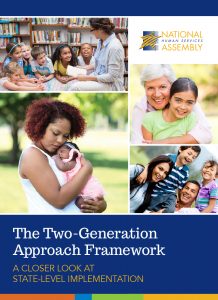The Two-Generation Approach Framework: A Closer Look at State-Level Implementation
September 16, 2016Building Family Well-Being with State-Level Two-Generation Frameworks
 The National Human Services Assembly has released “The Two-Generation Approach Framework: A Closer Look at State-Level Implementation” funded by The Annie E. Casey Foundation. The report explores how three states–Colorado, Connecticut, and Utah–are developing and implementing a Two-Generation (Two-Gen) framework in their human service programs. The Two-Gen approach builds well-being by working with both generations of families simultaneously to support early childhood education, elementary education, economic stability, and family engagement.
The National Human Services Assembly has released “The Two-Generation Approach Framework: A Closer Look at State-Level Implementation” funded by The Annie E. Casey Foundation. The report explores how three states–Colorado, Connecticut, and Utah–are developing and implementing a Two-Generation (Two-Gen) framework in their human service programs. The Two-Gen approach builds well-being by working with both generations of families simultaneously to support early childhood education, elementary education, economic stability, and family engagement.
Key Findings
The National Assembly interviewed state and local stakeholders to gain a deeper understanding of the policies, systems, and structures supporting the Two-Gen approach. The research indicates three distinct Two-Gen strategies at the state level:
- Colorado. The state’s agency-driven approach begins with the alignment and coordination of services and sharing of data, combined with legislative backing through recent changes to state policy.
- Connecticut. The state’s framework includes a pilot program that will build systems and program models within six communities, eventually serving as a template for scaling up Two-Gen programs statewide.
- Utah. The state legislature created an interagency commission to explore the extent of intergenerational poverty in the state, from which a work plan was developed to align agency data collection and programs all the way to the caseworker level to ensure that services are more intentionally and effectively connected.
Policy Opportunities, Challenges, and Lessons
Colorado, Connecticut, and Utah are on the vanguard of state implementation, developing innovative solutions to the structural barriers and challenges that have traditionally kept services for children and adults in silos. The three states have made significant contributions to the field’s understanding of how to best translate support for the Two-Gen approach into tangible solutions that fundamentally transform state policies, systems, and programs. The report highlights the importance of:
- Cultivating champions of the Two-Gen approach in the state legislature and executive cabinet;
- Developing unique ways to share data within and across state agencies to increase program efficiency;
- Identifying populations within the state who share the potential to maximize the outcomes of Two-Gen program delivery;
- Involving families in program design to ensure that services are tailored to the values of each community; and
- Ensuring program sustainability by building opportunities for long-term systems change into Two-Gen policies and programs.
The report brings to bear salient inflection points from the interviews across all three states, which represent the challenges that each state has faced and, in many cases, the solutions chosen to address them. State-level information includes: (1) background and context for the Two-Gen approach taken by each state; (2) an overview of the Two-Gen programs at the state level; and (3) a “policy map” providing a graphic representation of the Two-Gen framework in each state.

